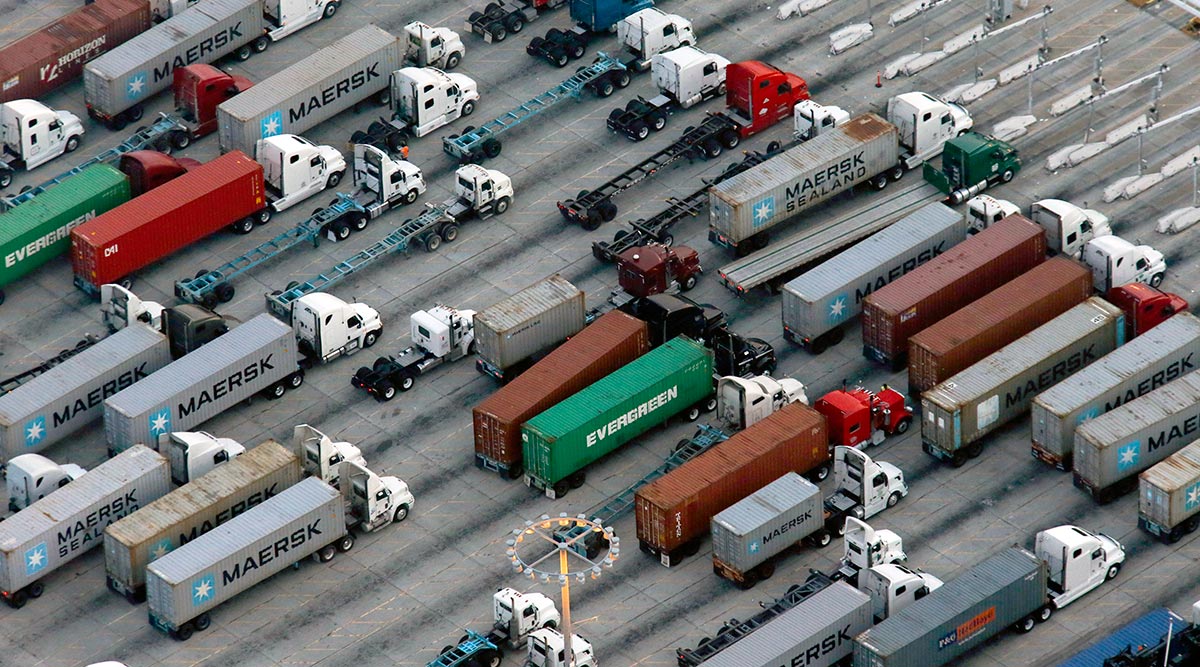Cargo Volumes, Truck Delays Rise at Ports of Los Angeles and Long Beach

The amount of time it took the average truck driver to do business at the two largest North America ports rose six minutes year-over-year in May due to backups at Total Terminals International, according to data from the Harbor Trucking Association.
The total turn time was 84 minutes at the two Southern California ports. The Port of Los Angeles, No. 1 in North America based on annual container volumes, had an average of 82 minutes. The Port of Long Beach, No. 2, averaged 87 minutes. The Harbor Trucking Association aggregates the data using GPS devices on drayage trucks from the moment they queue outside the entrance to when they cross the exit gate.
RELATED: Port of L.A. approves $1.17 billion budget to help terminals better handle trucks, ships
HTA Executive Director Weston LaBar told Transport Topics that the increased delays were due to the new shipping alliances. Maersk Line and Mediterranean Shipping Co. formed the 2M Alliance, and Hyundai Merchant Marine signed on as a strategic partner. Maersk operates the Pier 400-APM Terminals complex in Los Angeles, and Mediterranean and Hyundai bought Total Terminals International in Long Beach last January.
LaBar said that Maersk shifted its business to the Long Beach complex since the alliance took effect on April 1. As a result, Pier 400’s turn times dropped to 73 minutes from 93 minutes one year ago, but TTI’s rose to 139 minutes from 99 minutes.
Nevertheless, cargo volumes at the Port of Los Angeles increased 3.4% year-over-year last month, the busiest May in its 110-year history.
Stevedores handled 796,216 industry-standard 20-foot-equivalent units, or TEUs. Loaded imports grew 3.1% to 413,021, and exports rose 4.4% to 169,639.
“We continue to see balanced year-over-year growth, both on the import and export side of our operations,” said Gene Seroka, executive director of the Port of Los Angeles.
Through May, cargo volumes were 3.75 million, 8.5% ahead of the record-breaking 2016 total.
The Port of Long Beach processed 648,287 TEUs in May, a 1.2% increase year-over-year. The number of loaded import containers rose 1.8% to 336,594, but exports fell 14% to 118,786.
Port officials said May was the best month since September 2015.
“Last May was a great month, so we’re encouraged that we did even better this year,” said Mario Cordero, Port of Long Beach executive director.
Through May, cargo traffic has risen 4.1% to 2.79 million in 2017.
Meanwhile, Los Angeles Mayor Eric Garcetti and Long Beach Mayor Robert Garcia renewed their pledge to reach zero emissions at the two ports within 15 to 20 years, signing a joint declaration on June 12. The mayors said that the Clean Air Action Plan will include new investments in clean technology and a pilot program with 50 to 100 zero-emissions drayage trucks to begin in a few years.
“With the ports of Los Angeles and Long Beach ranked as the nation’s two largest ports, it is crucial to double down on our commitment to combating climate change by achieving the goals of the Paris Agreement and by committing to zero-emissions goals for the Clean Air Action Plan,” Garcia said. “The success of our ports has proven that you don’t have to choose between the environment and the economy.”
The ports of Los Angeles and Long Beach will release a timeline within 15 days and complete the update by November.
“We cannot wait until 2035, 18 years from now, in hopes of an unproven technology to replace the diesel-dominated freight movement system that emits more than 40% of all smog-forming pollutants in Southern California, and bypass a proven clean truck solution that exists today,” the California Natural Gas Vehicle Coalition said in a statement. “Replacing dirty diesel trucks with heavy-duty trucks that run on clean-burning renewable natural gas will improve our air immediately.”

